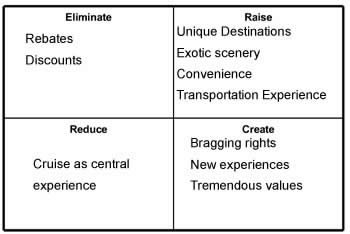This article is Part 3 of a review of the concept of Blue Ocean Strategy for Travel Agents. Click here for Parts 1 and 2.
In yesterday’s example, we created a biking event that evidenced blue ocean strategy. As a result, our travel package could operate without competition. Our biking program offered the participants the opportunity to pursue their biking passion in a series of exotic countries over a period of days, something many of the participants would not have ever thought about or even thought possible. We accomplished this neat trick by transporting our bikers from country to country aboard a cruise ship sailing the Caribbean.
However, I ask you, is it enough? Is a single instance of a biking event, or any similar blue ocean event, where you want your practice to be? Perhaps. Some good entrepreneur could build an entire business around such a program. Many of us, however, would want more. We want a varied travel practice not confined to a single destination or activity but to a relationship with clients. Is it possible to build an entire travel practice based on blue ocean strategies and principles? I believe it is. But we need to analyze and understand what we have acheived and how.
First, let’s analyze a blue ocean strategy in a two case studies using the “Eliminate-Reduce-Raise-Create” grid developed by the Blue Ocean theorists W. Chan Kim and Renee Mauborgne in their seminal work Blue Ocean Strategy. I should note that my abbreviated discussion of their work does not do them justice and that every travel consultant interested in Blue Ocean Strategies should obtain a copy of their work.
Kim and Mauborgne consider the case of Cirque du Soleil. The grid below is their analysis of how Cirque managed to create new value in their production, achieving differentiation while at the same time reducing costs and creating new value. In so doing, Cirque did not just build a “better” circus – they literally reconstructed the circus.

Cirque eliminated several components of the traditional circus such as animal acts, “celebrity” performers, and “three rings”. Each of these was considered vital components of a traditional circus. Yet, the cost structure of a circus was thereby increased beyond the actual value achieved. For example, obtaining an obscure Romanian trapeze artist for Barnum and Bailey was an expensive proposition and one that added only slight, incremental difference to those who attended the circus. Animal acts were incredibly expensive from the perspective of animal care, transportation and insurance.
This 365 Marketing Tip is sponsored by:
It may seem odd at first to consider “reducing” fun, humor and thrills, but consider the target audience for the traditional circus: children. Look across the grid at what was increased: a theme to the show, with a story line, music, intellectually stimulating acrobatics and wonder. The slapstick humor of the circus gave way to more sophisticated themes of Cirque. The appeal now is to a new, more affluent audience. Finally, Cirque raised the ante by staging their productions in new, exciting venues capable of servicing many more viewers.
Cirque du Soleil combined elements of circus and theater, reconstructed the appeal and eliminated the high cost structure. Now, let’s look at our example from yesterday.

Our biking event actually eliminated very little from the essential cruise experience. However, the cruise itself fell to the “background” of the event, becoming essentially transportation, room and board. Very nice transportation, room and board, but definitively moved to the background. We have “reconstructed” the cruise event. What has been eliminated are rebates and discounts which contribute to so much of the “cost” factors for travel consultants.
Over on the value side, the idea of traveling to multiple destinations on a cruise was raised to a new level as those various destinations became biking venues. Cruising suddenly becomes the most convenient way to travel from one destination to the next to experience not the cruise but the biking available in each port. The value created is extraordinary. The bikers get new bragging rights as they enjoy new destinations and experiences in each country. In essence, the cruise becomes the “value add” to our program.
We have achieved a travel program with no competition, of high value. No need to discount, to rebate. In fact, we can charge a premium. We are in blue oceans.
The question arises: how consistently can we achieve results like this? Did we just get lucky on our first example? Is it possible to use the grid analysis above to base an entire practice on blue ocean thinking? Can we find a way to achieve new value and experiences in each travel planning exercise?
Tomorrow: Yes we can.





3 thoughts on “Blue Ocean Strategy for Travel Agents: Moving from Transaction to Strategy”
Richard I agree with all you say. I would caution that to expand into a number of areas of travel and focus on the client relationship is good as long as you are the go to person and very knowledgeable of those areas you expand to. I really feel that the day of the generalist travel agent are gone. Again, people do not buy travel from us, they are buying our expertise, knowledge, and service, we then supply their travel.
so glad to see this series of articles in print — this has been my agency’s philosophy for the better part of the last 10 years. Thank you, Richard, for writing this series.
p.s. — in Part Three, please check the spelling of “achieved” and “abbreviated” in the text…is this your test to see if we really read the article — ha ha
Geoff: Blue Ocean Strategies allow for an agent to Niche into a specialty and to craft the niche in a very unique way. Agree 100%
Casey – Daggone it! Wanted – copy editor.